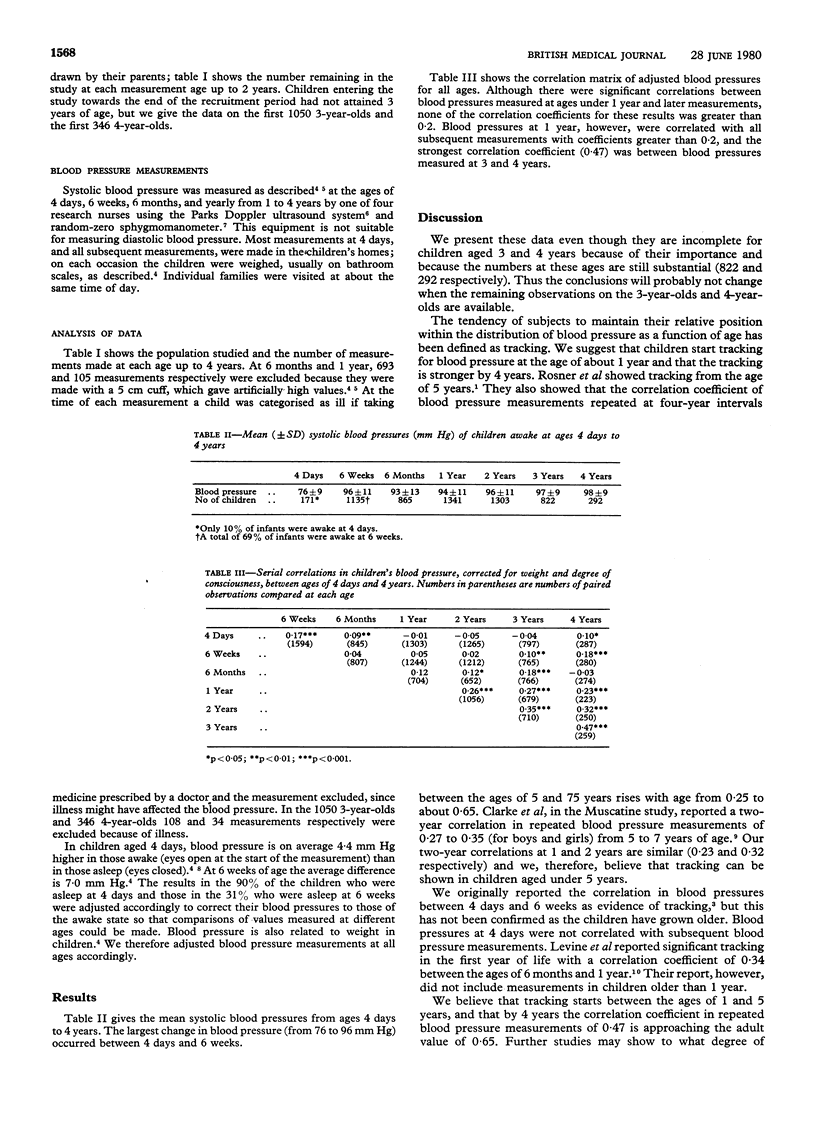Abstract
Systolic blood pressure were measured in 1797 infants aged 4 days and then repeated at 6 weeks, 6 months, 1 year and then yearly until 4 years of age. The mean pressure rose from 76 mm Hg at 4 days to 96 mm Hg at 6 weeks but did not vary appreciably between subsequent measurements. Serial correlation coefficients of blood pressure adjusted for weight and degree of consciousness were calculated, comparing measurements at each age. At ages under 1 year the correlation coefficients were relatively weak, though most were significant (r < 0.2). As the children grew older these serial correlations became stronger, so that the correlation coefficient in blood pressure between ages 3 and 4 years was 0.47. These observations suggest that "tracking" for blood pressure starts at about 1 year and is much stronger by 4 years. Taken in conjunction with the findings of other long-term follow-up studies in older children, this suggests that children develop blood pressures indicative of their adult values between 1 and 4 years.
Full text
PDF


Selected References
These references are in PubMed. This may not be the complete list of references from this article.
- Clarke W. R., Schrott H. G., Leaverton P. E., Connor W. E., Lauer R. M. Tracking of blood lipids and blood pressures in school age children: the Muscatine study. Circulation. 1978 Oct;58(4):626–634. doi: 10.1161/01.cir.58.4.626. [DOI] [PubMed] [Google Scholar]
- De Swiet M., Fancourt R., Peto J. Systolic blood pressure variation during the first 6 days of life. Clin Sci Mol Med. 1975 Dec;49(6):557–561. doi: 10.1042/cs0490557. [DOI] [PubMed] [Google Scholar]
- Elseed A. M., Shinebourne E. A., Joseph M. C. Assessment of techniques for measurement of blood pressure in infants and children. Arch Dis Child. 1973 Dec;48(12):932–936. doi: 10.1136/adc.48.12.932. [DOI] [PMC free article] [PubMed] [Google Scholar]
- Levine R. S., Hennekens C. H., Klein B., Gourley J., Briese F. W., Hokanson J., Gelband H., Jesse M. J. Tracking correlations of blood pressure levels in infancy. Pediatrics. 1978 Jan;61(1):121–125. [PubMed] [Google Scholar]
- Rosner B., Hennekens C. H., Kass E. H., Miall W. E. Age-specific correlation analysis of longitudinal blood pressure data. Am J Epidemiol. 1977 Oct;106(4):306–313. doi: 10.1093/oxfordjournals.aje.a112466. [DOI] [PubMed] [Google Scholar]
- Wright B. M., Dore C. F. A random-zero sphygmomanometer. Lancet. 1970 Feb 14;1(7642):337–338. doi: 10.1016/s0140-6736(70)90709-9. [DOI] [PubMed] [Google Scholar]
- Zinner S. H., Margolius H. S., Rosner B., Kass E. H. Stability of blood pressure rank and urinary kallikrein concentration in childhood: an eight-year follow-up. Circulation. 1978 Nov;58(5):908–915. doi: 10.1161/01.cir.58.5.908. [DOI] [PubMed] [Google Scholar]
- de Swiet M., Fayers P., Shinebourne E. A. Blood pressure survey in a population of newborn infants. Br Med J. 1976 Jul 3;2(6026):9–11. doi: 10.1136/bmj.2.6026.9. [DOI] [PMC free article] [PubMed] [Google Scholar]


